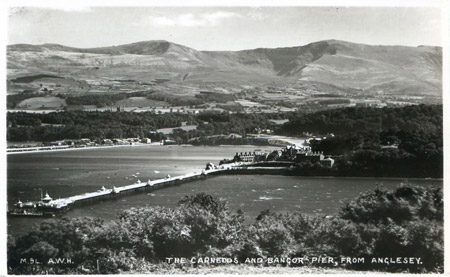powered
by
FreeFind
Piers
in Wales
All images link to larger
copies
Cardiff
To be
added
Penarth
Penarth, one
of several major coal ports on the Welsh south coast, also boasted
a resort that was competing in the lucrative paddle steamer trade
across the Bristol Channel. In 1894 work began on a pier designed
by H F Edwards and commissioned by the Penarth Promenade and
Landing Pier Company Ltd. Under the management of the Mayohs
brothers, Penarth Pier was completed the following year, opening
on 4th February 1895.
Built in cast
iron with a timber deck, the original pier was no more than a
landing jetty and promenade. Facilities were extended in 1907
when a wooden pavilion was erected at the pier-head, and shops
placed along the neck. When Penarth Pier was sold to the local
council in 1926, they later made further additions including
a new concrete landing stage and a shore ward end pavilion.
The history
of Penarth Pier has not been without incident. During the August
Bank Holiday of 1931 a fire started in the seaward end pavilion,
spreading almost the entire length of the pier within just a
few minutes. The pier head, deck and shops were re-built at a
cost of £3,157, but the wooden pier-head pavilion has never
been replaced.
Soon after the
Second World War, Penarth Pier experienced a second major mishap
when the 7,000-ton Canadian Port Royal Park was driven
against the pier in a severe gale, destroying a large section
of the structure. Repairs took two years to complete and cost
some £28,000 to underpin the cast iron columns and install
concrete columns at various points.
Steamer traffic
had always been the mainstay of Penarth Pier and it was a cause
for great concern when the White Funnel cruises, run by one of
the area's most famous shipping operators, P & A Campbell
Ltd of Bristol, ceased operating in 1981. The Balmoral
and Waverley, operated by the Paddle Steamer Preservation
Society, continue to call. Considerable sums of money have been
spent on fully restoring the 650ft (197m) pier and, in May 1998,
a formal re-opening of Penarth Pier took place.
(www.theheritagetrail.co.uk)
Double-ended
paddle steamer Kate at Penarth beach, using a precarious-looking
portable jetty
There
was an 1865 Kate built by John Payne of Bristol
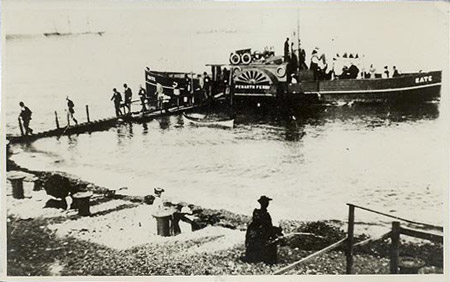
Postcard
of Penarth Pier
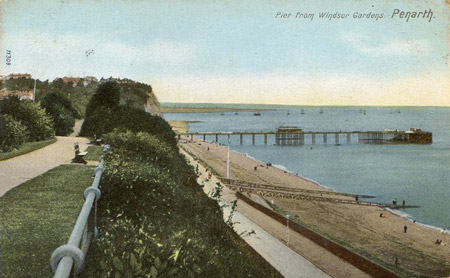
Postcard
of Penarth Pier
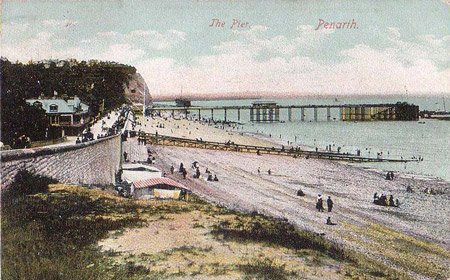
Postcard
of Penarth Pier
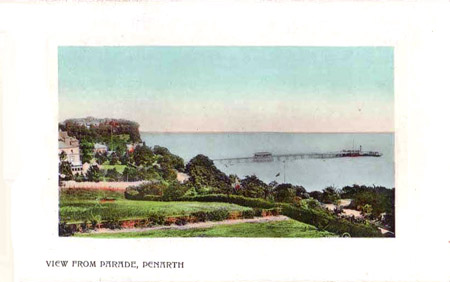
Postcard
of Penarth Pier
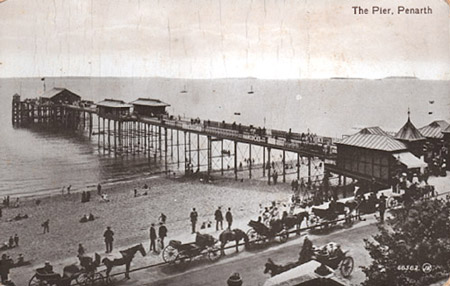
Postcard
of Penarth Pier entrance by Noah's Ark (Penarth), posted 1915
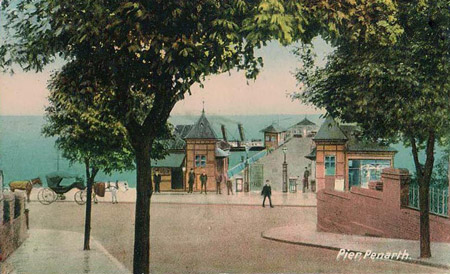
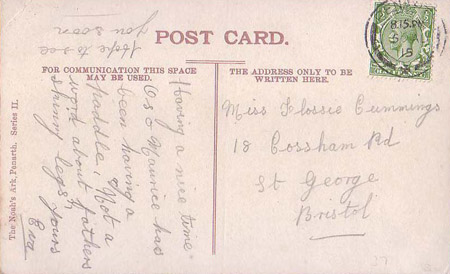
Postcard
of Penarth Pier entrance, by Noah's Ark (Penarth)
Alternative copy of
card above
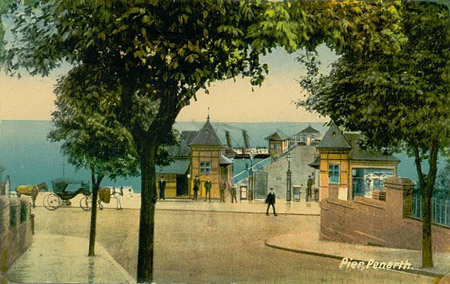
Postcard
of Penarth Pier
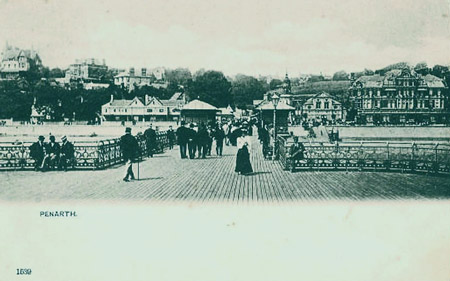
Postcard
of view from Penarth Pier
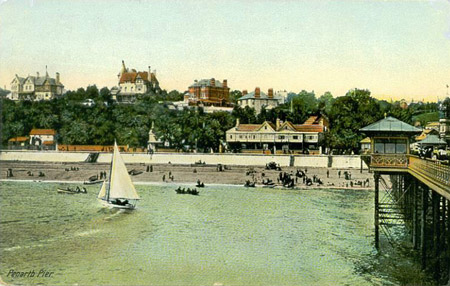
Postcard
of view from Penarth Pier
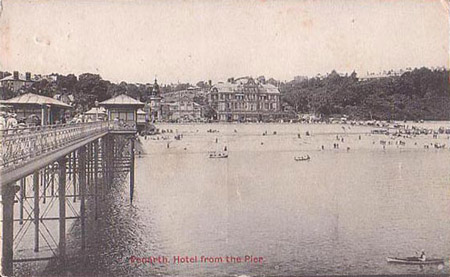
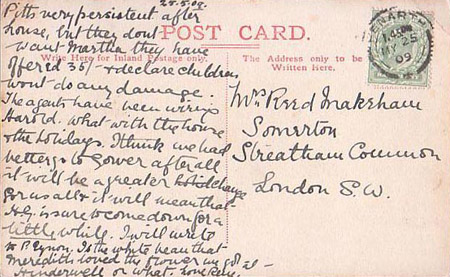
Excel
Series postcard of Penarth Pier, posted 1936, but taken prior
to the 1931 fire
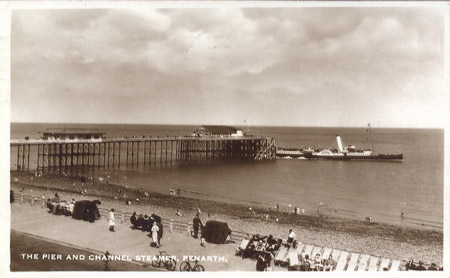
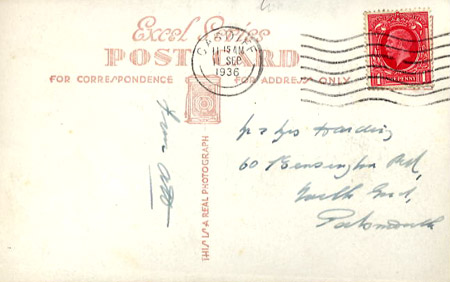
Postcard
of Penarth Pier after 1930s rebuilding with a pavilion (compare
to card above)
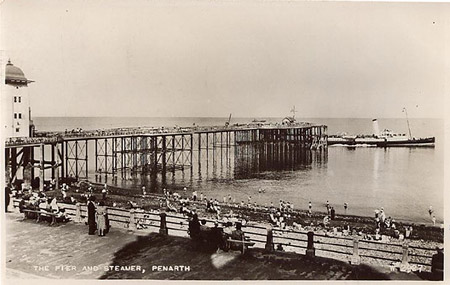
Postcard
of Penarth Pier with 1930s entrance
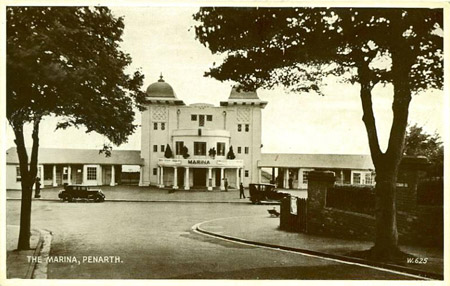
Valentine's
multi-view postcard of Penarth, including the 1930s rebuilt pier
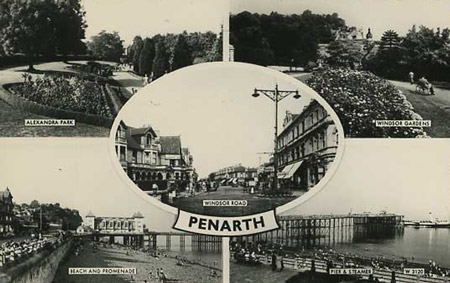
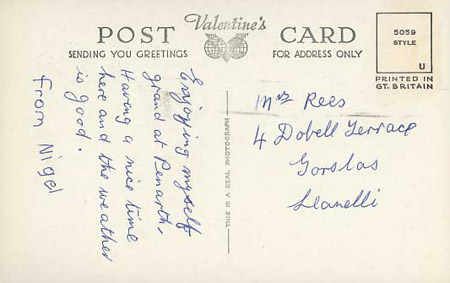
Penarth Pier seen from PS Waverley
Photo:
© Ian Boyle, 4th June 2005
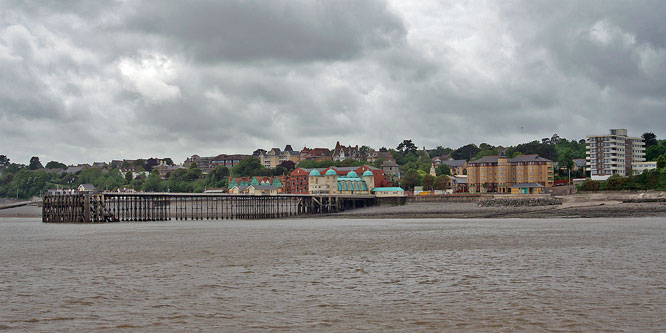
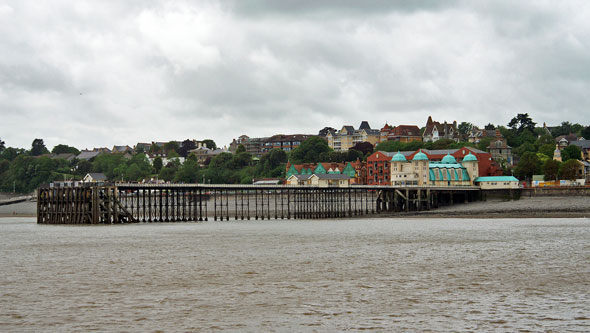
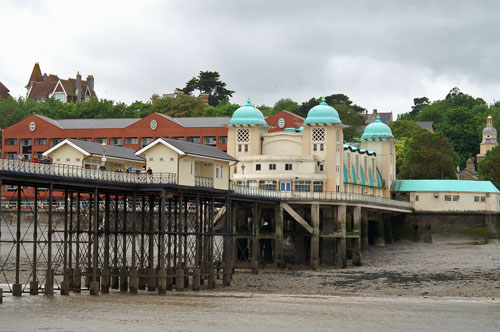
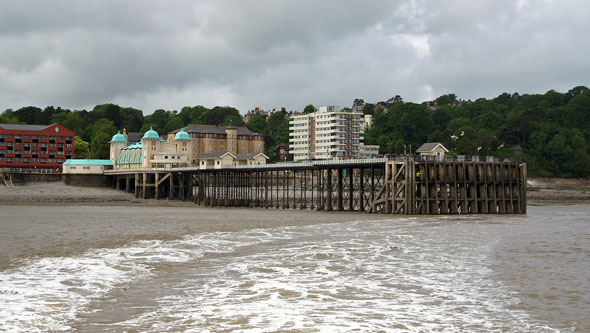
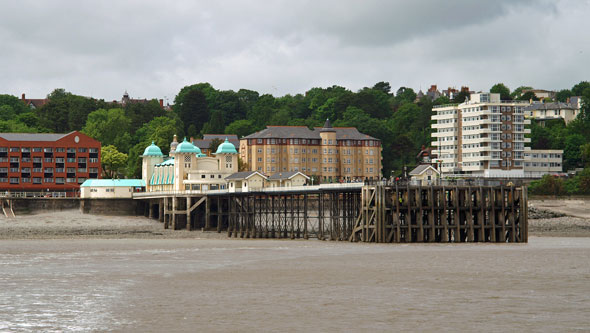
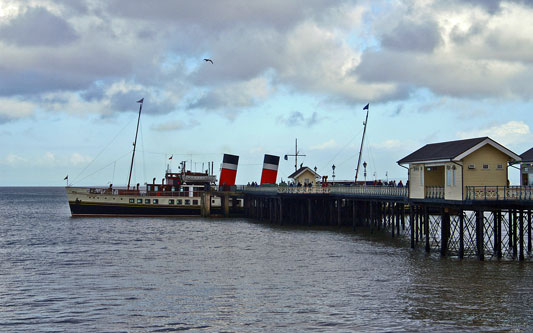
Aberavon - North Pier
Aberavon had
North and South breakwaters for the harbour, of which the South
Pier was built of stone. The North Pier was a less substantial
wooden structure with a wooden promenade deck.
Postcard
of Aberavon Pier
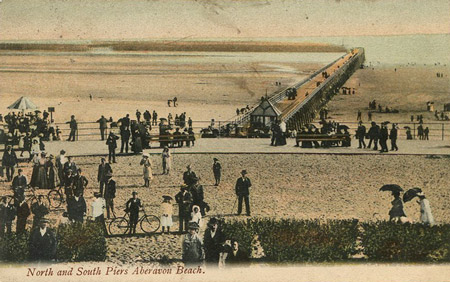
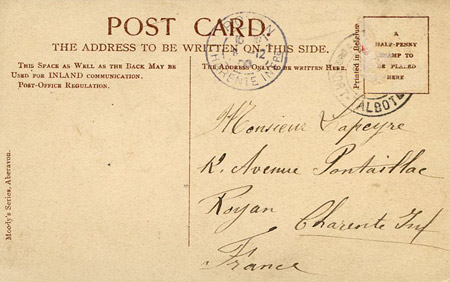
Mumbles
Mumbles Head
is a rocky promontory that overlooks the gentle sweep of Swansea
Bay. Designed by W Sutcliffe Marsh and costing £17,000,
Mumbles Pier was commissioned as the terminus for the Swansea
to Mumbles railway. Frequented by the many steelworkers and miners
living in the area, the pier was popular for its regular steamer
excursions to other resorts on the Welsh Coast, along with the
resorts of North Devon and Somerset.
Mumbles Pier
was constructed of lattice steelwork on cast iron piles, with
a pitch pine deck. Originally 835ft (253m) in length, Mumbles
Pier was officially opened on 10th May 1898. Designed as a landing
jetty, Mumbles Pier only provided a bandstand and some amusement
stalls for its visitors. The Pier Hotel was built on the pier
forecourt at the same time.
Mumbles Pier's
history has been largely uneventful. A lifeboat station and walkway
was added at a right-angle to the main pier neck c1920, and is
still used by the RNLI. On 1st October 1937 the running of Mumbles
Pier was taken over by AMECO Ltd, which continues to the present
day. In keeping with most other southern piers Mumbles Pier was
sectioned as a defence measure in 1940 and it was some years
after the war before the pier was finally repaired, re-opening
on 9th June 1956. Substantial repair work was required prior
to re-opening and it was during this time that a three-tiered
concrete landing stage, on steel piles, was added at the pier-head.
Shortly after re-opening the Swansea to Mumbles railway was closed.
A new amusement
complex was built at the shore ward end in 1966. Currently Mumbles
Pier remains fully open except for a small section of deck on
the right hand side of the pier-head that is under going restoration.
The shore ward facilities include the Pier Hotel and the re-furbished
pavilion. (www.theheritagetrail.co.uk)
Postcard
of Mumbles Pier, with steam train
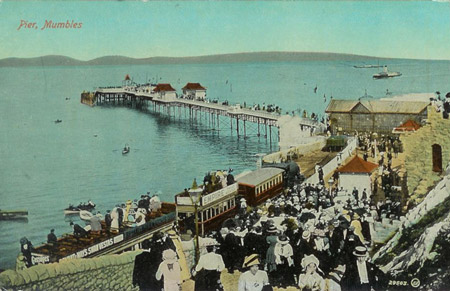 Postcard
of Mumbles Pier
Postcard
of Mumbles Pier
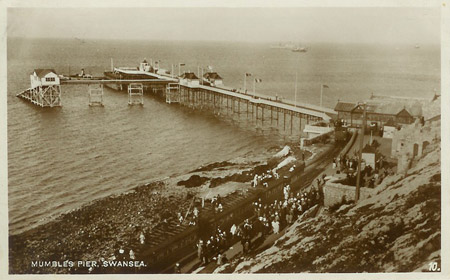 Postcard
of Mumbles Pier
Postcard
of Mumbles Pier
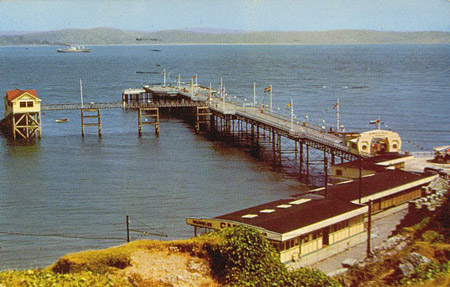
Postcard
of Mumbles Pier
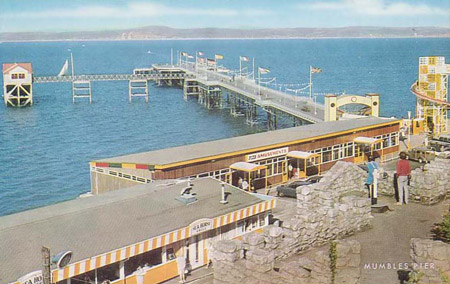
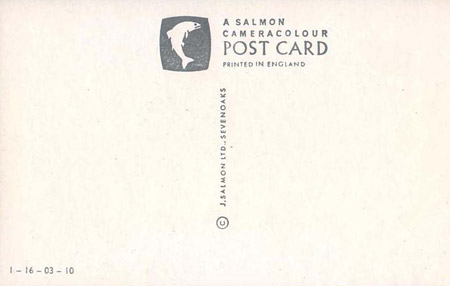
Tenby - Royal Victoria
Pier
Tenby Royal
Victoria Pier was built in 1897 and officially opened in 1899
by the Duke of York. It was designed as a steamer jetty for service
from other South Wales resorts and North Devon/Somerset piers.
It was demolished slowly between 1946 and 1953.
Postcard
of Tenby Royal Victoria Pier
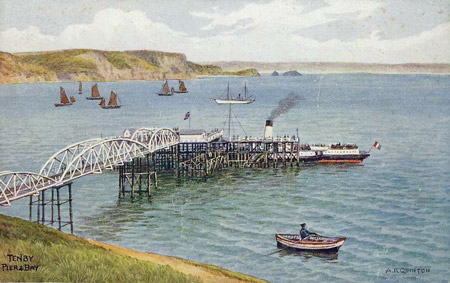 Barry
Railway steamer at Tenby Royal Victoria Pier
Barry
Railway steamer at Tenby Royal Victoria Pier
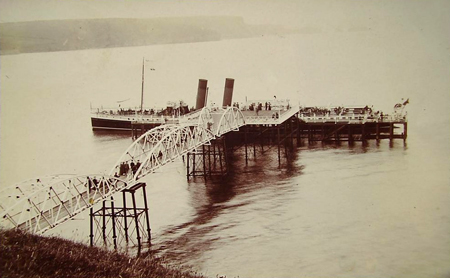 Postcard
of Tenby Royal Victoria Pier
Postcard
of Tenby Royal Victoria Pier
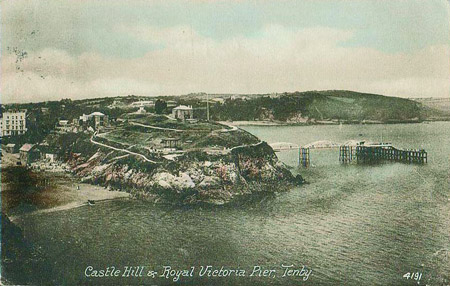
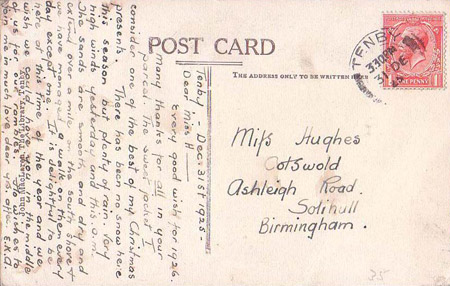 Tenby
also had a stone harbour jetty
The
Royal Victoria Pier is in the background, behind the lifeboat
pier
Tenby
also had a stone harbour jetty
The
Royal Victoria Pier is in the background, behind the lifeboat
pier
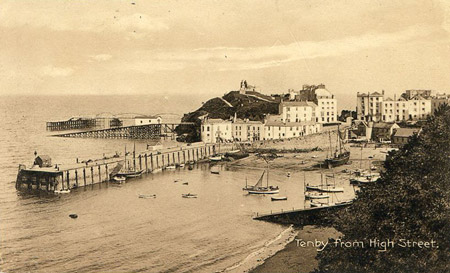 Postcard
of Tenby harbour and Royal Victoria Pier
Postcard
of Tenby harbour and Royal Victoria Pier
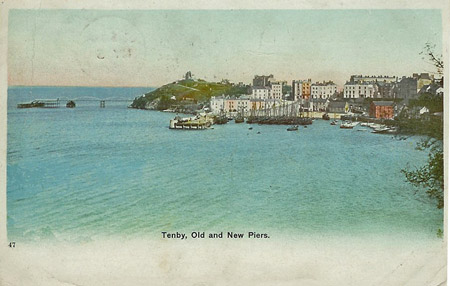 The
stone jetty at Tenby harbour
The
stone jetty at Tenby harbour
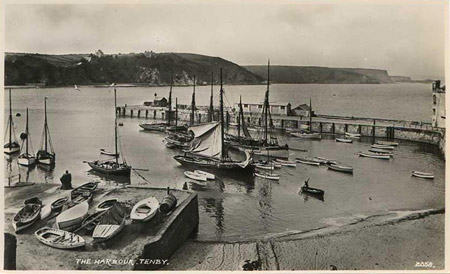 The
stone jetty at Tenby harbour
The
stone jetty at Tenby harbour
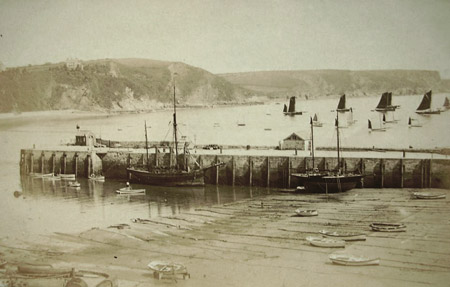 Postcard
of stone jetty at Tenby harbour
Postcard
of stone jetty at Tenby harbour
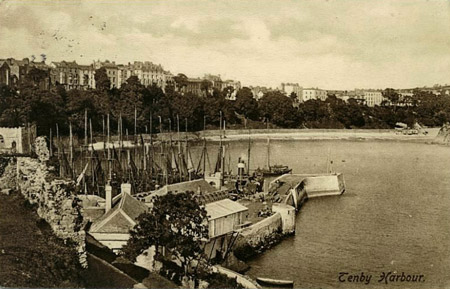 The
stone jetty at Tenby harbour
The
stone jetty at Tenby harbour
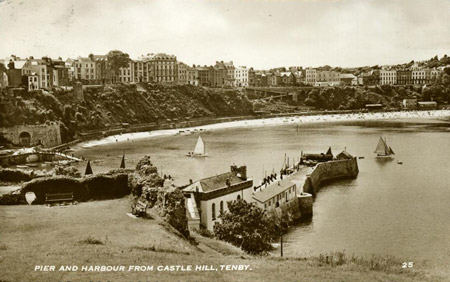
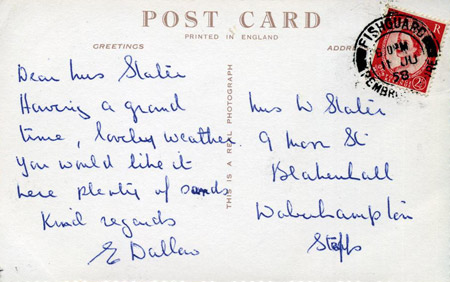
Lower Fishguard
The
stone jetty at Lower Fishguard
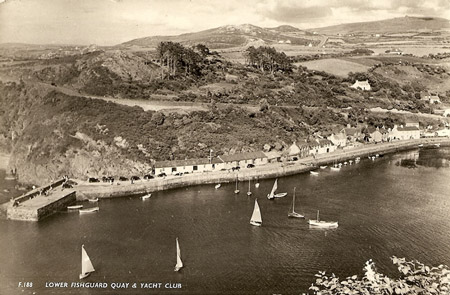
Aberystwyth - Royal Pier
Aberystwyth
pier was the first purpose built pleasure pier in Wales. Commissioned
by the Aberystwyth Pier Promenade Company, it was designed and
constructed by the famous engineer Eugenius Birch, in conjunction
with contractors J. E. Dowson. The 800ft (242m) Aberystwyth Royal
Pier opened on Good Friday in 1865, which happened to coincide
with the arrival of the Cambrian railway in Aberystwyth.
Just seven months
later in January 1866, a severe storm washed away a 100ft (30m)
section at the seaward end. This disaster had a considerable
impact on the company, that eventually led to the sale of the
pier a few years later. In 1872 the new owners replaced the missing
section with a slimmer 230ft (70m) extension, and added a gallery
and refreshments room at the head.
Towards the
end of the 19th century Aberystwyth Royal Pier received a glass
pavilion at the shore ward end of the pier, designed by G Croydon-Marks.
The new pavilion consisted of three aisles surmounted by glass
domed roofs, the elevations being ribbed and decorated in the
Gothic style. With the capacity to accommodate 3,000 people,
it was opened by the Princess of Wales on 26th July 1896.
Further storm
damage in 1938 reduced the length of the pier by half, and by
the 1970s the remaining neck was in such a bad state of repair
that it was closed to the public on safety grounds. This remains
the case today, but the pavilion, is still open. In 1979 Aberystwyth
Royal Pier was purchased by the Don Leisure Group, and in 1986
they spent £250,000 on improvements to the remainder of
the 300ft (91m) pier. Planning permission was granted for the
construction of a new pier alongside the original, but the project
never came to fruition. A new snooker hall and restaurant were
opened in 1987. (www.theheritagetrail.co.uk)
Postcard
of Aberystwyth Pier
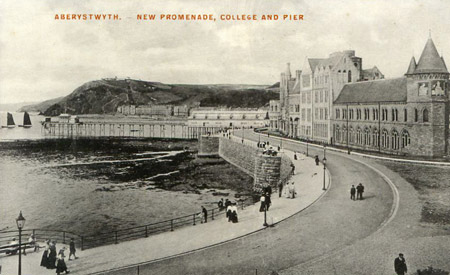
Caernarvon Pier
Photographic
postcard of Snowdon at Caernarvon pier
Rhos
Trevor,
later
St
Trillo (1),
is passing on the left
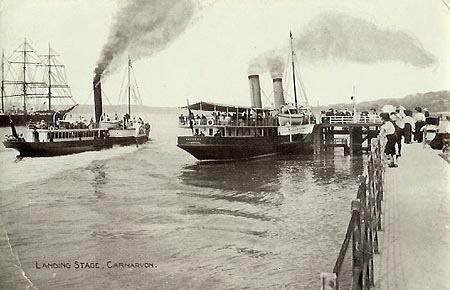 Photochrom
Co postcard of Snowdon at Caernarvon Pier.
Photochrom
Co postcard of Snowdon at Caernarvon Pier.
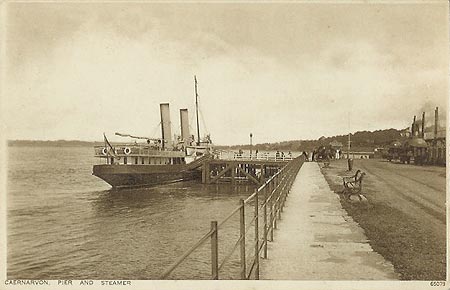 Photograph
of Queen of the Isles at Caernarvon, 1pm, Tuesday 8th
September 1967.
Photograph
of Queen of the Isles at Caernarvon, 1pm, Tuesday 8th
September 1967.
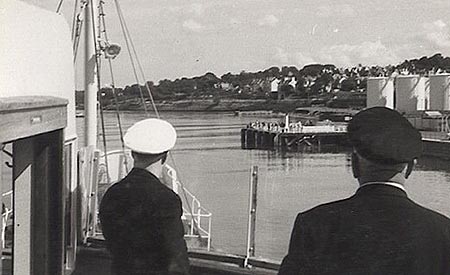
Menai Bridge
Postcard
of the view from Menai Bridge Pier
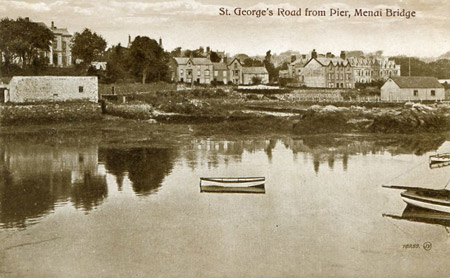 Valentine's
postcard of St Elvies at Menai Bridge Pier
Card
posted April 1910
Valentine's
postcard of St Elvies at Menai Bridge Pier
Card
posted April 1910
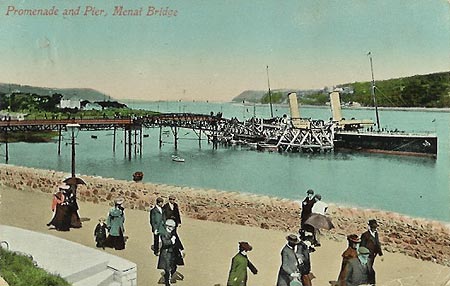 Photographic
postcard of St Elvies arriving at Menai Bridge Pier.
Photographic
postcard of St Elvies arriving at Menai Bridge Pier.
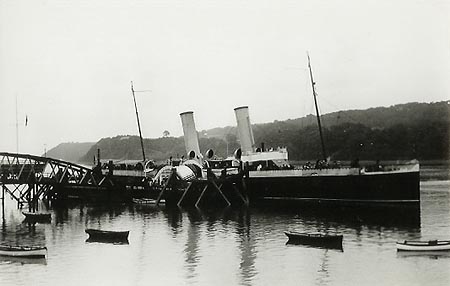 La
Marguerite
at Menai Bridge pier.
La
Marguerite
at Menai Bridge pier.
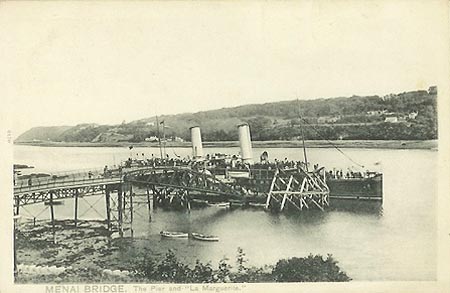 La
Marguerite
at Menai Bridge.
La
Marguerite
at Menai Bridge.
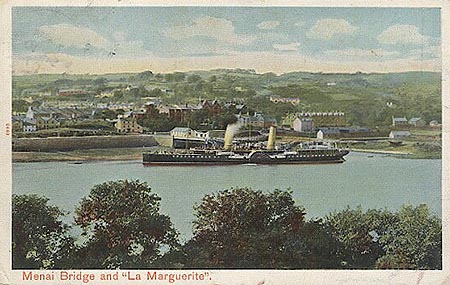 R.Frith
postcard of St Tudno (3) at Menai Bridge Pier
R.Frith
postcard of St Tudno (3) at Menai Bridge Pier
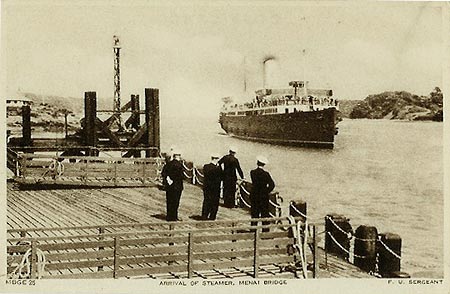 R.Frith
postcard of St Tudno (3) at Menai Bridge Pier
Taken
shortly after the card above
R.Frith
postcard of St Tudno (3) at Menai Bridge Pier
Taken
shortly after the card above
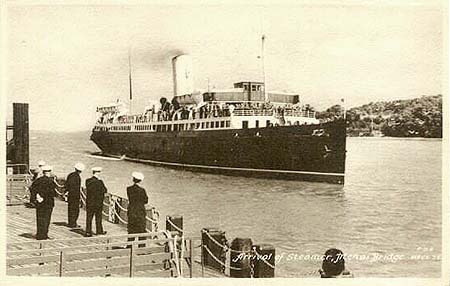 Postcard
of St Seiriol (2) at Menai Bridge Pier.
Postcard
of St Seiriol (2) at Menai Bridge Pier.
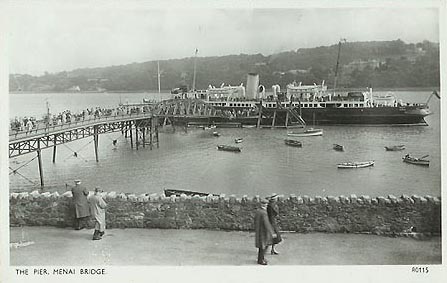 Postcard
of St Seiriol (2) at Menai Bridge Pier.
Postcard
of St Seiriol (2) at Menai Bridge Pier.
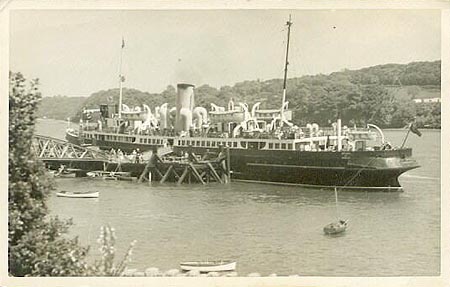 Bamforth
postcard of Queen of the Isles, at Menai Bridge, whilst
on charter to P&A Campbell for North Wales excursions.
Bamforth
postcard of Queen of the Isles, at Menai Bridge, whilst
on charter to P&A Campbell for North Wales excursions.
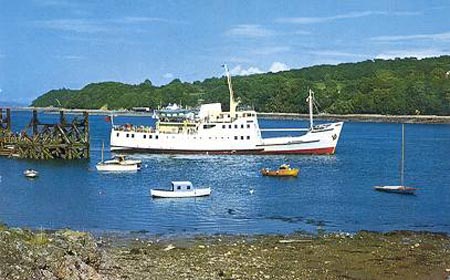 Photograph
of Queen of the Isles, at Menai Bridge, whilst on charter
to P&A Campbell for North Wales excursions.
Photograph
of Queen of the Isles, at Menai Bridge, whilst on charter
to P&A Campbell for North Wales excursions.
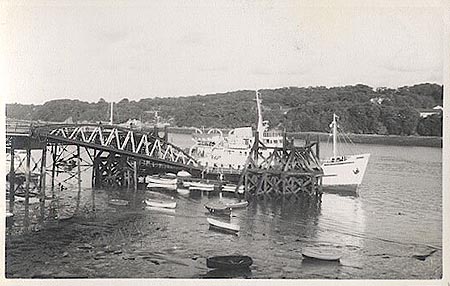
Bangor - Garth Pier
The construction
of Bangor Pier did not commence until the mid 1890s, making it
one of the later piers to be built. Designed by JJ Webster of
Westminster, and at a cost of some £14,475, Bangor's new
1550ft (470m) pier opened to the public on 14th May 1896 with
a ceremony performed by Lord Penrhyn.
Constructed
largely in steel, with cast iron columns and screw piles, Bangor
Pier comprised of a wooden deck punctuated with a series of elegant
polygonal kiosks with steeply pitched roofs, ornamental lamps
and handrails, and a pontoon landing stage at the head. A 3ft
(90cm) gauge railway for baggage handling was also included in
the design, but was removed in 1914.
Handling steamers
from Douglas, Liverpool and Blackpool the operation of the pier
remained uneventful until 1914 when a coaster, the Christiana,
broke free of her moorings and collided with the neck of the
pier causing considerable damage. The resulting gap was bridged
with a temporary gangway until a permanent repair was finally
made in 1921.
Bangor Pier
was finally closed to the public for safety reasons in 1971.
Ownership of the pier passed to Arfon Borough Council in 1974
who took the decision to demolish it. The City Council put in
an objection, and successfully obtained a Grade II listed building
status for the pier as it was considered to be one of the three
finest surviving piers in Britain. Subsequently purchasing the
pier for a nominal one penny in 1975, the City Council set about
the daunting task of raising the required funds for a full restoration.
Taking a further seven years to secure the finances, the project
was able to commence in 1982 and took a further six years to
complete. Bangor Pier was reopened by the Marquis of Anglesey
on 7th May 1988.
(www.theheritagetrail.co.uk)
Postcard
of Garth Pier, Bangor
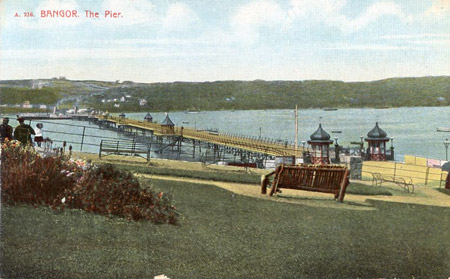 Postcard
of Garth Pier, Bangor
Postcard
of Garth Pier, Bangor
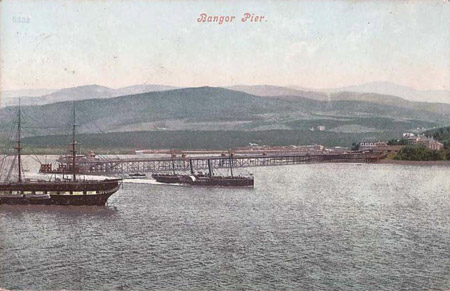
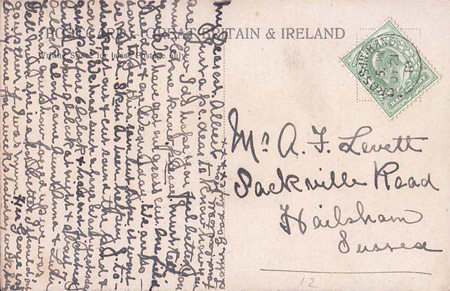 Postcard
of Garth Pier, Bangor
Postcard
of Garth Pier, Bangor
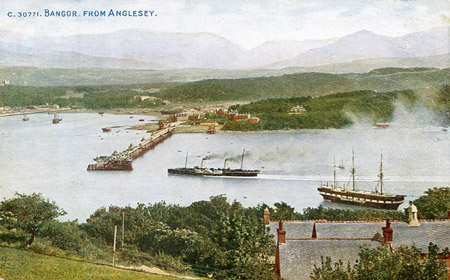 Postcard
of Garth Pier, Bangor
Postcard
of Garth Pier, Bangor
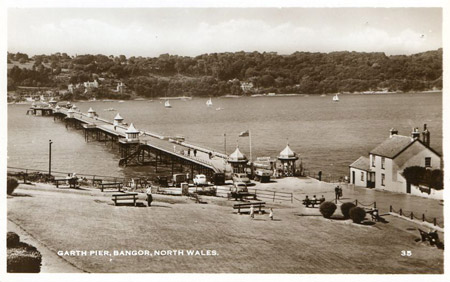 JV photographic
postcard 97370 of St Elvies passing Garth Pier, Bangor
JV photographic
postcard 97370 of St Elvies passing Garth Pier, Bangor
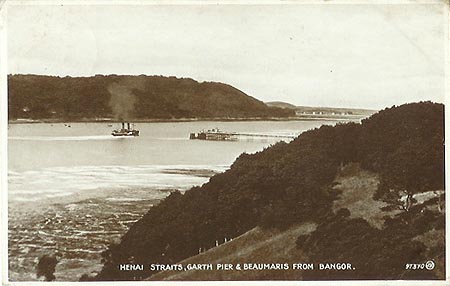 Postcard
of Garth Pier, Bangor
Postcard
of Garth Pier, Bangor
